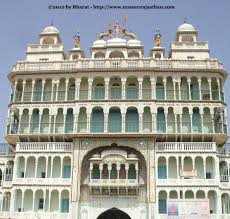Jhunjhunu (Hindi: झुन्झुनू) is a town in the state of Rajasthan, India and the administrative headquarters of Jhunjhunu District. It is located a 180 km from Jaipur and 245 km from Delhi. The town is famous for the frescos on its grand Havelis; a special artistic feature of this region.
 Jhunjhunu lies in the core of the well known erstwhile Shekhawati province. Thakur Shardul Singh won Jhunjhunu by defeating (in 1730) Rohilla Khan "Raseela", the last Nawab of Jhunjhunu. This is clear from the poetry, made by the Charan of Shekhawats in the Rajasthani language
Jhunjhunu lies in the core of the well known erstwhile Shekhawati province. Thakur Shardul Singh won Jhunjhunu by defeating (in 1730) Rohilla Khan "Raseela", the last Nawab of Jhunjhunu. This is clear from the poetry, made by the Charan of Shekhawats in the Rajasthani language
Satrahso Satashiye, Agahan Mass Udaar,
Sadu linhe jhunjhunu, Sudi Athen Sanivaar".
Another poem in Rajasthani language on Shardul Singh -
Sade, linho Jhunjhunu, Lino amar patai,
Bete pote padaute pidhi sat latai.
The above poetry was composed by the Charan of Shekhawats after Jhunjhunu was conquered. The translation is that Shardul Singh has taken Jhunjhunu on a lifelong lease. Now the succeeding seven generations would be benefited.
Shardul Singh had three marriages. He married firstly, in 1698, Thukrani Sahaj Kanwar Biki Ji Sahiba, daughter of Manroop Singh Bika of Nathasar; married secondly, Thukrani Sirey Kanwar Biki Ji Sahiba, daughter of Mukal Singh Bika of Nathasar; and married thirdly Thukrani Bakhat Kanwar Mertani Ji Sahiba, daughter of Devi Singh Mertiya of Poonglota (Marwar), near Degana, and had issue. He died 17 April 1742. He had six sons, namely,
-
Thakur Jorawar singh, (by the first wife), born at Kant, married and had issue. He died 1745. He built Jorawargarh fort, and was the ancestor of the families of Taen, Malsisar, Gangiyasar, Mandrella, etc.
-
Thakur Kishan singh, (by the third wife), born 1709, the ancestor of the families of Khetri, Arooka, Seegra, Alsisar etc.
-
Kunwar Bahadur Singh, (by the third wife), born 1712, died 1732.
-
Thakur Akhay singh, (by the third wife), born 1713, built Akhegarh Fort. Died without issue in 1750.
-
Thakur Nawal singh Bahadur (by 3rd wife), born 1715, ancestor of the families of Nawalgarh, Mahensar, Dorasar, Mukundgarh, Narsinghani,Balonda and Mandawa. He died 24 February 1780.
Thakur Keshri singh, (by 3rd wife), born 1728, ancestor of the families of Dundlod, Surajgarh and Bissau, fifth and youngest son, died 1768.
Unfortunately, his son Bahadur Singh expired at an early age. As a result his estate was divided into five equal shares. The administration by his five sons was cumulatively known as Panchpana.
After his death the estate was divided equally among his five sons. Shardul Singh was a man of a religious bent of mind, as he built many temples, such as Kalyan Ji Mandir and Gopinath Ji Ka Mandir at Jhunjhunu. To commemorate the sweet memory of his father, his sons made a monumental dome at Parasrampura. Its fresco painting is worth seeing.
All the five sons of Shardul Singh Ji were very brave, capable and efficient rulers. They raised many new thikanas, towns, forts and palaces; they encouraged the baniyas (merchants) in trade. As a result they grew rich and made many Havelies.
Currently the famous Rani Sati Dadi Mandir is a main tourist attraction apart from its religious significance. It receives more than 1 lac footfalls a day. Due to this temple the city has earned an importance in serving the tourist and "yatris". The term "mela" is used to represent the "Bhadi Mawas" day, a day of religious importance at this temple. People from all over the India gather in this mandir to offer prayer on this day.